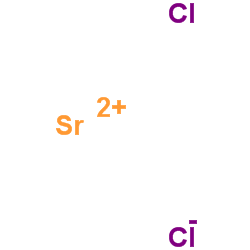Strontium chloride

Strontium chloride structure
|
Common Name | Strontium chloride | ||
|---|---|---|---|---|
| CAS Number | 10476-85-4 | Molecular Weight | 158.526 | |
| Density | 3 g/mL at 25ºC(lit.) | Boiling Point | 1250ºC | |
| Molecular Formula | Cl2Sr | Melting Point | 873ºC | |
| MSDS | Chinese USA | Flash Point | 1250°C | |
| Symbol |

GHS05 |
Signal Word | Danger | |
| Name | strontium dichloride |
|---|---|
| Synonym | More Synonyms |
| Density | 3 g/mL at 25ºC(lit.) |
|---|---|
| Boiling Point | 1250ºC |
| Melting Point | 873ºC |
| Molecular Formula | Cl2Sr |
| Molecular Weight | 158.526 |
| Flash Point | 1250°C |
| Exact Mass | 157.843323 |
| LogP | 1.37900 |
| Index of Refraction | 1.65 |
| Storage condition | 2-8°C |
CHEMICAL IDENTIFICATION
HEALTH HAZARD DATAACUTE TOXICITY DATA
MUTATION DATA
|
| Symbol |

GHS05 |
|---|---|
| Signal Word | Danger |
| Hazard Statements | H318 |
| Precautionary Statements | P280-P305 + P351 + P338 |
| Personal Protective Equipment | Eyeshields;full-face respirator (US);Gloves;multi-purpose combination respirator cartridge (US);type ABEK (EN14387) respirator filter |
| Hazard Codes | Xi:Irritant |
| Risk Phrases | R37/38;R41 |
| Safety Phrases | S26-S39 |
| RIDADR | NONH for all modes of transport |
| WGK Germany | 1 |
| RTECS | WK8400000 |
| HS Code | 2827399000 |
| HS Code | 2827399000 |
|---|
|
Novel Protamine-Based Polyelectrolyte Carrier Enhances Low-Dose rhBMP-2 in Posterolateral Spinal Fusion.
Spine 40 , 613-21, (2015) A rodent posterolateral spinal fusion model.This study evaluated a protamine-based polyelectrolyte complex (PEC) developed to use heparin in enhancing the biological activity of low-dose recombinant h... |
|
|
Strontium chloride Sr 89 for treating pain from metastatic bone disease.
Am. J. Health Syst. Pharm. 52(20) , 2189-95, (1995) The role of strontium chloride Sr 89 in the palliative treatment of pain associated with metastatic bone disease is reviewed. Conventional therapies to relieve metastatic bone pain include nonopioid a... |
|
|
[A case of lung cancer pain relief and safe return home by strontium chloride].
Gan To Kagaku Ryoho. 40(4) , 533-5, (2013) Strontium chloride 89 (89Sr) is used as a systemic radiopharmaceutical therapy for the palliation of pain in patients with metastatic bone cancer. A 64-year-old man had previously undergone an operati... |
| MFCD00011249 |
| EINECS 231-201-3 |
| Strontium chloride |
| Strontium dichloride |
| Strontium Chloride, Anhydrous |

